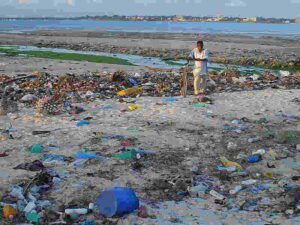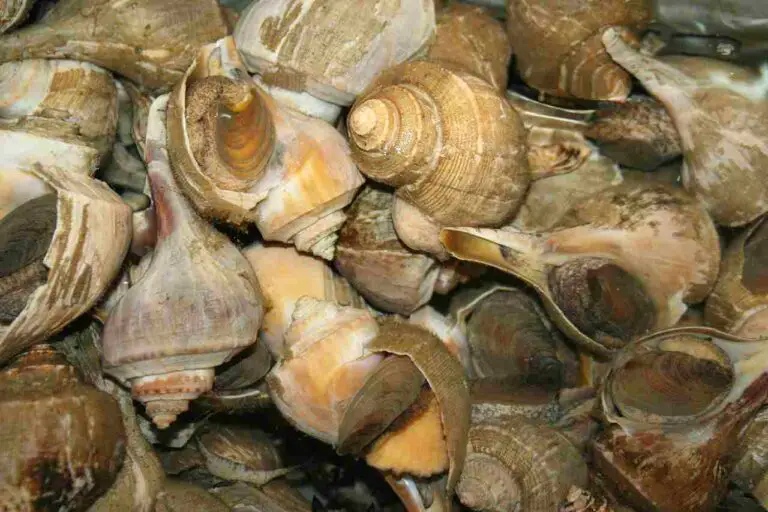5 Types of Ocean Pollution Explained
Types of ocean pollution are; ocean acidification, plastic, debris, nutrient, toxin, and submarine noise pollution.
This article discusses the types of ocean pollution, as follows;
1). Marine Plastic Pollution (as one of the Types of Ocean Pollution)
Plastic pollution is arguably the most prominent type of pollution that occurs in oceans.
Millions of tons of plastics enter into oceans each year, from various sources, including municipal and commercial waste.
Plastic waste is usually the most visible marine pollutant, and accounts for up to 80% of the total pollutant volume in marine ecosystems [2].
These plastics are responsible for several hazardous ocean pollution effects on human health and marine organisms.
With regards to human health, marine microplastics often contain chemicals that can cause endocrine disruption [1], along with psychological, cardiovascular and reproductive problems.
Marine organic populations can incur fatalities due to ingestion or entanglement in plastic waste, leading to loss of biodiversity.

2). Marine Debris Pollution
Marine debris, also known as ‘marine litter’, includes all forms of insoluble contaminant materials in polluted oceans.
It is important to clarify that marine debris does not mean the same thing as marine plastic, but in many cases it could also include plastic materials.
Marine debris is mostly terrestrial in origin, and enters oceans as a result of poor waste management practices, and lack of sustainable development considerations.
Also, marine debris could include organic biomass in the form of wood; as well as inorganic materials.
Marine debris affects the environment by causing aesthetic pollution. In the ocean, these materials can significantly harm marine life, posing a threat to their survival.
Sea navigation challenges for humans can also occur due to marine debris pollution.
3). Nutrient and Toxin Pollution (as one of the Types of Ocean Pollution)
Marine nutrient pollution is the accumulation of excessive amount of nutrients in oceans, so that unfavorable physicochemical and biochemical conditions are resultantly established.
Two common marine nutrient pollutants are phosphorus and nitrogen [3], which could come from polluted stormwater or runoff from agricultural lands where chemical fertilizer is used.
Marine nutrient pollution can cause what is known as ‘eutrophication’, whereby algal blooms grow in a rapid and hazardous manner, and dominate the water body.
This can deplete oxygen levels, reduce clarity, alter pH, temperature; and create toxic conditions that are harmful for agricultural organisms.
On the other hand, marine toxin pollution is the release of toxic chemicals into marine water.
These chemicals are usually the result of human activity; and the phenomenon, context, and mechanism of toxin pollution can be considered similar to those of nutrient pollution.
Like nutrient pollution, marine toxin pollution could result from agricultural chemicals. It could also be from industrial waste, effluents from nuclear power plants, and from greywater management systems.
Environmental remediation for such cases of marine pollution can be expensive, due to the need for elaborate measures to isolate and remove soluble chemicals in water.
4). Submarine Noise Pollution
Submarine pollution; also called ‘underwater noise’, ‘acoustic’, or ‘sound’ pollution, is simply the propagation of strong sound waves through the ocean.
The main cause of submarine noise pollution is human activity [4].
This activity could include exploration and mining that both cause seismic disturbance, or hydro-vibratory noise from ship and submarine navigation, or from offshore installations like wind farms and wave power converters.
Sound pollution affects marine life by causing the transmission of unnatural acoustic signals, which many marine organisms mistake for natural stimuli, and react to. By reacting to noise pollution, the entire marine ecosystem experiences unsustainable changes in reproductive, hibernative and migratory patterns, that could have negative effects on organic survival, abundance and biodiversity.
Technological innovation in the form of more efficient ships, sonars, underwater vehicles, drilling equipment and offshore renewable energy systems, can all help to address this problem.
Policies controlling sea navigation, exploration and installation activities, can also reduce marine noise pollution.
5). Ocean Acidification (as one of the Types of Ocean Pollution)
Ocean acidification is large-scale, significant decrease in pH levels in the ocean.
It is caused mainly by the presence of excessive amounts of dissolved carbon dioxide (CO2) in the ocean [5].
This CO2 is usually among other greenhouse gases released from human activities like electricity generation, agriculture and mining.
It is also usually released among other anhydrous gases that are responsible for similar (pH-reducing) environmental hazards like acid rain.
Since oceans naturally absorb carbon dioxide, marine acidification can be seen as an indication that the natural capacity of the ocean as a carbon sink, has been exceeded.
Measures that help to address marine acidification include energy transition to less carbon-intensive energy resources, implementation of carbon trading rules, and the use of carbon removal technologies like direct air-carbon capture.
Conclusion
Types of ocean pollution are;
1. Marine Plastic Pollution
2. Marine Debris Pollution
3. Nutrient and Toxin Pollution
4. Submarine Noise Pollution
5. Ocean Acidification
References
1). Chen, Q.; Allgeier, A.; Yin, D.; Hollert, H. (2019). “Leaching of endocrine disrupting chemicals from marine microplastics and mesoplastics under common life stress conditions.” Environment International 130:104938. Available at: https://doi.org/10.1016/j.envint.2019.104938. (Accessed 27 November 2022).
2). Jambeck, J.; Geyer, R.; Wilcox, C.; Siegler, T. R.; Perryman, M.; Andrady, A. L.; Narayan, R.; Law, K. L. (2015). “Marine pollution. Plastic waste inputs from land into the ocean.” Science 347(6223):768-771. Available at: https://doi.org/10.1126/science.1260352. (Accessed 27 November 2022).
3). Ngatia, L., III, J. M. G.;Moriasi, D.; Taylor, R. (2019). “Nitrogen and Phosphorus Eutrophication in Marine Ecosystems.” In (Ed.), Monitoring of Marine Pollution. IntechOpen. Available at: https://doi.org/10.5772/intechopen.81869. (Accessed 27 November 2022).
4). Rodrigo, F. J.; Ramis, J.; Carbajo, J.; Poveda, P. (2022). “Underwater Anthropogenic Noise Pollution Assessment in Shallow Waters on the South-Eastern Coast of Spain.” J. Mar. Sci. Eng. 2022, 10(9), 1311. Available at: https://doi.org/10.3390/jmse10091311. (Accessed 27 November 2022).
5). Webb, A.; Leedham-Elvidge, E.; Hughes, C.; Hopkins, F.; Malin, G.; Bach, L. T.; Schulz, K.; Brussaard, C.; Stuhr, A.; Riebesell, U.; Liss, P. S. (2016). “Effect of ocean acidification and elevated fCO2 on trace gas production by a Baltic Sea summer phytoplankton community.” Biogeosciences 13(15):4595-4613. Available at: https://doi.org/10.5194/bg-13-4595-2016. (Accessed 27 November 2022).



